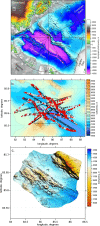Low-degree mantle melting controls the deep seismicity and explosive volcanism of the Gakkel Ridge
- PMID: 35661698
- PMCID: PMC9166806
- DOI: 10.1038/s41467-022-30797-4
Low-degree mantle melting controls the deep seismicity and explosive volcanism of the Gakkel Ridge
Abstract
The world's strongest known spreading-related seismicity swarm occurred in 1999 in a segment of the Gakkel Ridge located at 85°E as a consequence of an effusive-explosive submarine volcanic eruption. The data of a seismic network deployed on ice floes were used to locate hundreds of local earthquakes down to ∼25 km depth and to build a seismic tomography model under the volcanic area. Here we show the seismicity and the distribution of seismic velocities together with the 3D magmatic-thermomechanical numerical model, which demonstrate how a magma reservoir under the Gakkel Ridge may form, rise and trigger volcanic eruptions in the rift valley. The ultraslow spreading rates with low mantle potential temperatures appear to be a critical factor in the production of volatile-rich, low-degree mantle melts that are focused toward the magma reservoirs within narrow magmatic sections. The degassing of these melts is the main cause of the explosive submarine eruptions.
© 2022. The Author(s).
Conflict of interest statement
The authors declare no competing interests.
Figures




References
-
- DeMets, C., Gordon, R. G., Argus, D. F. & Stein, S. Effect of recent revisions to the geomagnetic reversal time scale on estimate of current plate motions. Geophys. Res. Lett. 10.1029/94GL02118 (1994).
-
- Sella GF, Dixon TH, Mao A. REVEL: a model for recent plate velocities from space geodesy. J. Geophys. Res. Solid Earth. 2002;107:pp.ETG–11. doi: 10.1029/2000JB000033. - DOI
-
- Cochran, J. R., Kurras, G. J., Edwards, M. H. & Coakley, B. J. The Gakkel Ridge: Bathymetry, gravity anomalies, and crustal accretion at extremely slow spreading rates. J. Geophys. Res. Solid Earth10.1029/2002JB001830 (2003).
-
- Ryan WBF, et al. Global multi-resolution topography synthesis. Geochem. Geophys. Geosyst. 2009;10:1525–2027. doi: 10.1029/2008GC002332. - DOI
-
- Schlindwein V. Teleseismic earthquake swarms at ultraslow spreading ridges: indicator for dike intrusions? Geophys. J. Int. 2012;190:442–456. doi: 10.1111/j.1365-246X.2012.05502.x. - DOI
Grants and funding
LinkOut - more resources
Full Text Sources

